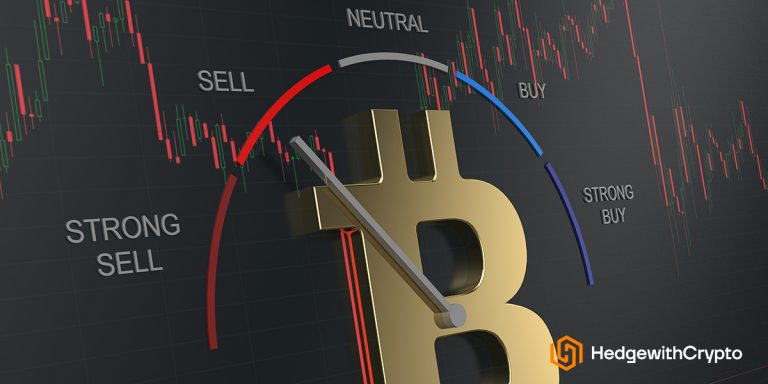This Is What Will Happen To Bitcoin In A Recession (It’s Not Recession Proof)
Hedge With Crypto aims to publish information that is factual and accurate as of the date of publication. For specific information about a cryptocurrency exchange or trading platform please visit that provider’s website. This information is general in nature and is for education purposes only. Hedge With Crypto does not provide financial advice nor does it take into account your personal financial situation. We encourage you to seek financial advice from an independent financial advisor where appropriate and make your own enquiries.
Key takeaways:
- Bitcoin has never faced a recession before, investors may choose to hold cash instead of Bitcoin, whose price will ebb and flow with the risk appetite of investors.
- Bitcoin could benefit from the lack of trust in fiat currencies and become a safe haven asset against economic downturns.
- It is likely that Bitcoin will decline in price with traditional markets in a recession, but may rebound quicker for investors looking for a safe haven to store their wealth due to its decentralized nature and limited supply.
- History has shown that Bitcoin can outpace traditional assets in the recovery from times of economic uncertainty.
TABLE OF CONTENTS
The accompanying slowdown in growth and fall in spending power result in worrying times for many individuals. It can certainly make investors evaluate a crypto portfolio, which, in 2022, may include Bitcoin. Bitcoin was originally launched in 2009, amid the last full-blown recession. Since then, the world's leading cryptocurrency has not yet had to face a comparable economic environment. Which begs the question, what could happen to Bitcoin in a recession-scale event? This is what we hope to uncover in this article.
It's Difficult To Say If Bitcoin Would Survive A Recession
It is impossible to say if Bitcoin will survive a recession – as Bitcoin has never faced a recession in the past. However, there are certain facts that we can use to infer its potential stability during such a period. Firstly, the pseudonymous Satoshi Nakamoto created Bitcoin as a result of the last global recession. It was the cataclysmic failure of the global economic system that prompted Nakamoto to make the blockchain and accompanying cryptocurrency that we know today. It was created to be independent and not reliant on any centralized third-party government or organization.
The global economy has become increasingly interconnected. In the past, if one economy failed, it may not have significantly affected other countries. However, in today’s environment, a threat to the economy of one country can become a threat to all. While Bitcoin’s self-reliance makes the asset a riskier investment, it is also why it is likely to continue operating regardless of how the macroeconomic environment changes.
Also working in Bitcoin’s favor is its capped supply and steady flow rate. Only 21 million Bitcoins will ever be created, with just under 2 million Bitcoins left to mine. Once all coins have been mined, no more will enter the circulating supply. This has allowed Bitcoin to position itself as a ‘store of value’. In inflationary markets that often accompany recessions, global currencies can lose value which leads to less spending power. Even though bear markets, Bitcoin has provided an answer to this spending power problem. Moreover, Bitcoin is a good inflation-hedging asset that has outperformed gold.

Accompanying the capped supply is Bitcoin’s steady flow rate. The number of newly mined Bitcoin entering circulation occurs at a consistent and dependable rate. It is even shrinking with time as a result of Bitcoin halving events. While other commodities may suffer from oversupply, the Bitcoin consensus algorithm ensures that new coins are released in a consistent manner, which helps to avoid oversupply and a potential drop in price. A capped supply and steady flow rate mean that, as popularity increases, the future price of Bitcoin should only move in one direction.
Although the above points are encouraging, in a recession Bitcoin’s price will almost certainly be affected. The coin remains one of the riskiest assets available within the market. Bitcoin’s instability and decentralized nature are why it is firmly placed in the ‘risk-on’ asset class. As a result, the price of Bitcoin will ebb and flow with the risk appetite of investors. At times of economic hardship, investors may rather hold more cash, than place capital into riskier assets such as Bitcoin.
Related: What are the main risks of Bitcoin?
Bitcoin As A Recession-Proof Investment
The decentralized nature of Bitcoin could make it the perfect asset in a recession. However, emphasis needs to be placed on the word ‘could’. Since its launch in 2009, Bitcoin has arguably solidified itself within the current economic environment. The coin has reached institutional status with several hedge funds holding BTC within a portfolio, many high-end brokers now offering BTC investment options to clients, and several international organizations accumulating BTC on balance sheets.
The introduction of companies and institutions into the crypto space has formed an increasing correlation between technology stocks and Bitcoin. Tech stocks, which are represented by the Nasdaq 100 basket, have been closely following Bitcoin’s price action since the start of the COVID-19 pandemic in March 2020 (as shown below). Unfortunately, history shows that at times of recession, stocks tend to fall in value. If the two markets remain correlated, Bitcoin could fall if the stock market crashes. Investors should be aware that, in a recession, the price of BTC is unlikely to rebound until the strength of the global economy returns. Once that happens, history has shown that BTC has the potential to outpace the returns offered by nearly every other asset class.
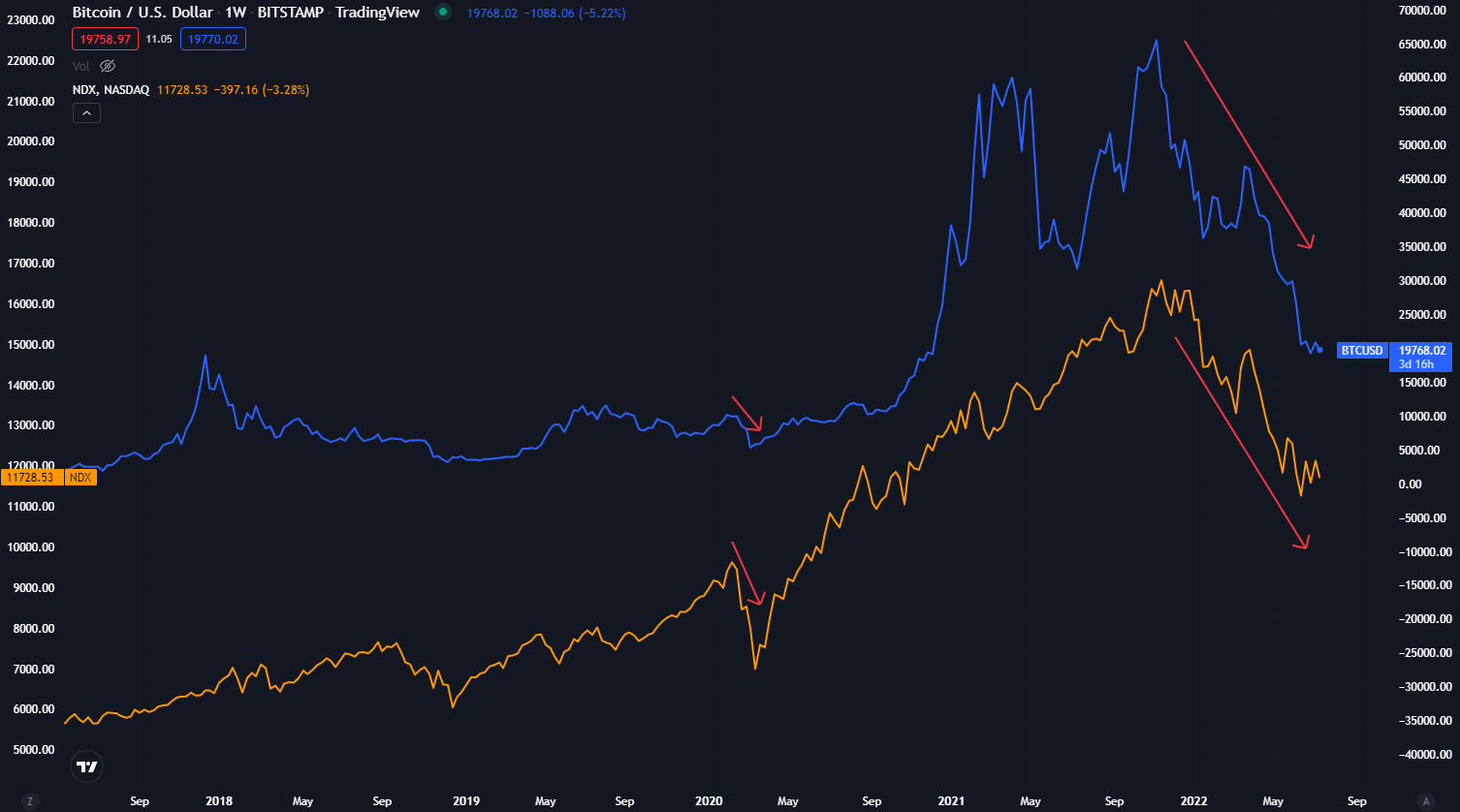
Another important difference to remember is that while individual organizations may suffer in a recession—even fold in some cases—Bitcoin can continue to operate thanks to its decentralized network of mining pools. Bitcoin investors can, therefore, take some comfort in the fact that a downturn in economic growth is unlikely to impact the network's operations. Bitcoin will continue to exist.
Ready to invest? Find out how to buy Bitcoin.
This Is How USD Would Affect Bitcoin
Although the price of Bitcoin is quoted in USD, the relationship between these two assets runs a little deeper. History shows that Bitcoin and USD have had both negative and positive correlations in the past. However, negative correlations are much more frequent. Typically, when the strength of the USD weakens, the strength of Bitcoin increases. Likewise, when the strength of the USD increases, the strength of Bitcoin weakens.
Between March 2020 and April 2021, the USD dollar index (DXY), fell from $102 to $89. Over the same period, Bitcoin's price increased from $6500 to $64,000. A similar relationship was also witnessed during Bitcoin’s bull cycle in 2017. While a negative correlation is more common and arguably healthier for BTC, there are also times when USD and Bitcoin display a positive correlation. These times are often followed by periods of significant bearish correction and volatility for Bitcoin. This poses the question of the stability of Bitcoin if the US dollar crashed.
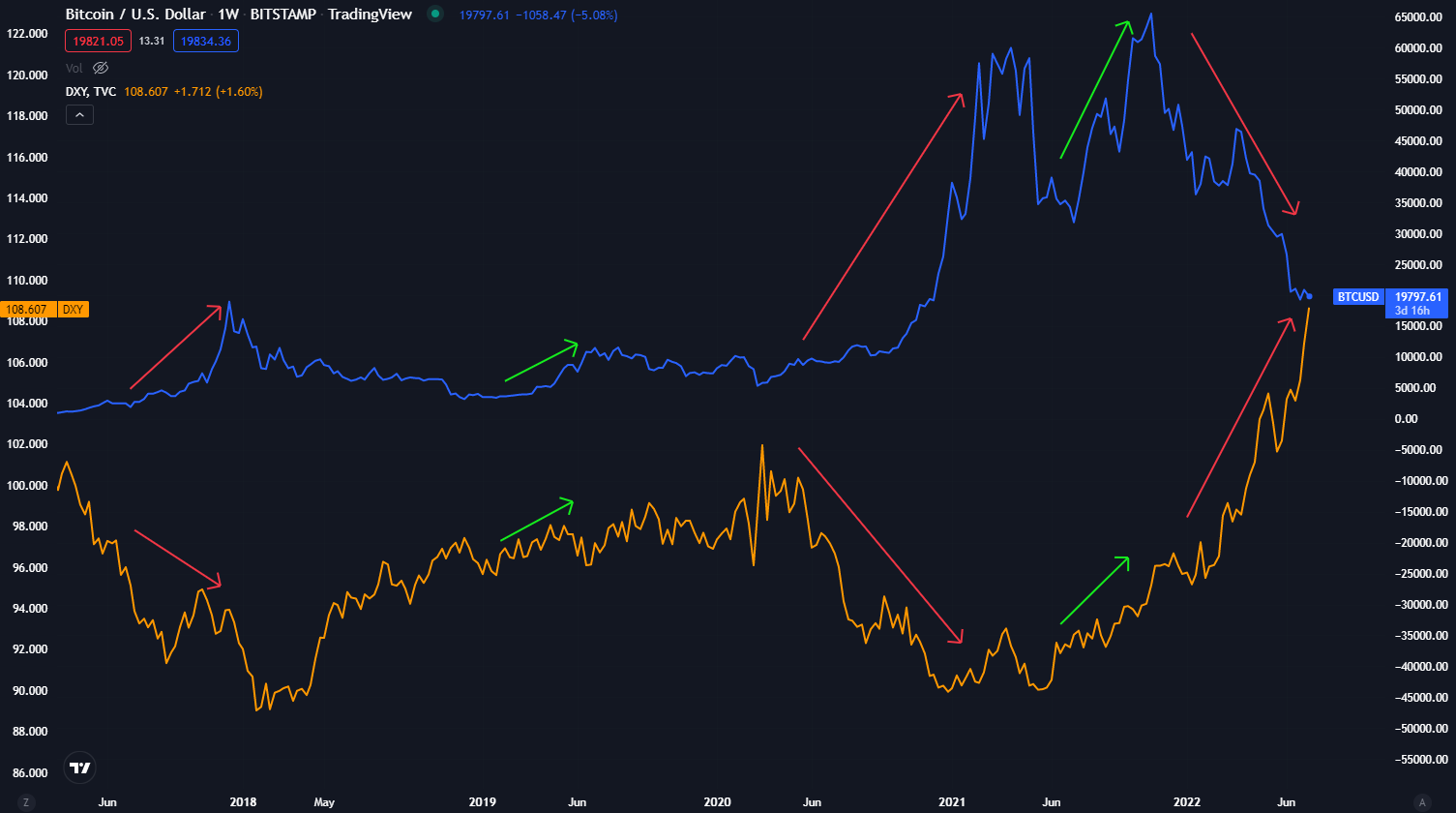
From June 2021 to November 2021, the USD and Bitcoin moved in a positive correlation. Both USD and Bitcoin were increasing in strength. Since November 2021, the DXY has continued to push higher while Bitcoin has fallen over 75% from all-time highs. This relationship between USD and Bitcoin is an important one, particularly during recessions, when cash is often touted as ‘King’. If the demand for cash is high, which would drive the strength of the USD, Bitcoin is likely to suffer in the medium to long term.
Importantly, where these two assets diverge is the effects of inflation. The amount of USD in circulation has exponentially increased since the Covid-19 pandemic. Over 80% of all USD in existence was printed since January 2020. This has devalued all USD in circulation and increased the price of goods and services for all. However, with a limited supply of 21 million, Bitcoin does not suffer from the same problem.
Bitcoin Is Not Immune To A Recession
Bitcoin is not immune to a recession. Just like stocks, crashes have become part of the crypto cycle and many in the industry believe that each crash is necessary to remove inefficient projects and leave room for successful innovations to grow. The price of Bitcoin has declined several times in the past 13 years. Like most assets, as Bitcoin has entered price discovery mode and has recorded a new all-time high, the price eventually needs to cool off which leads to a correction. Let’s look at an example.
In 2013, Bitcoin prices retraced 80% from an all-time high of $1000. In 2017, Bitcoin prices retraced 84% from an all-time high of $20,000. In 2020, Bitcoin prices dropped by 63% due to the COVID-19 pandemic. In 2021, Bitcoin prices began to retrace from an all-time high of $69,000. At the time of writing, the bottom of that bear market has not been clearly established.
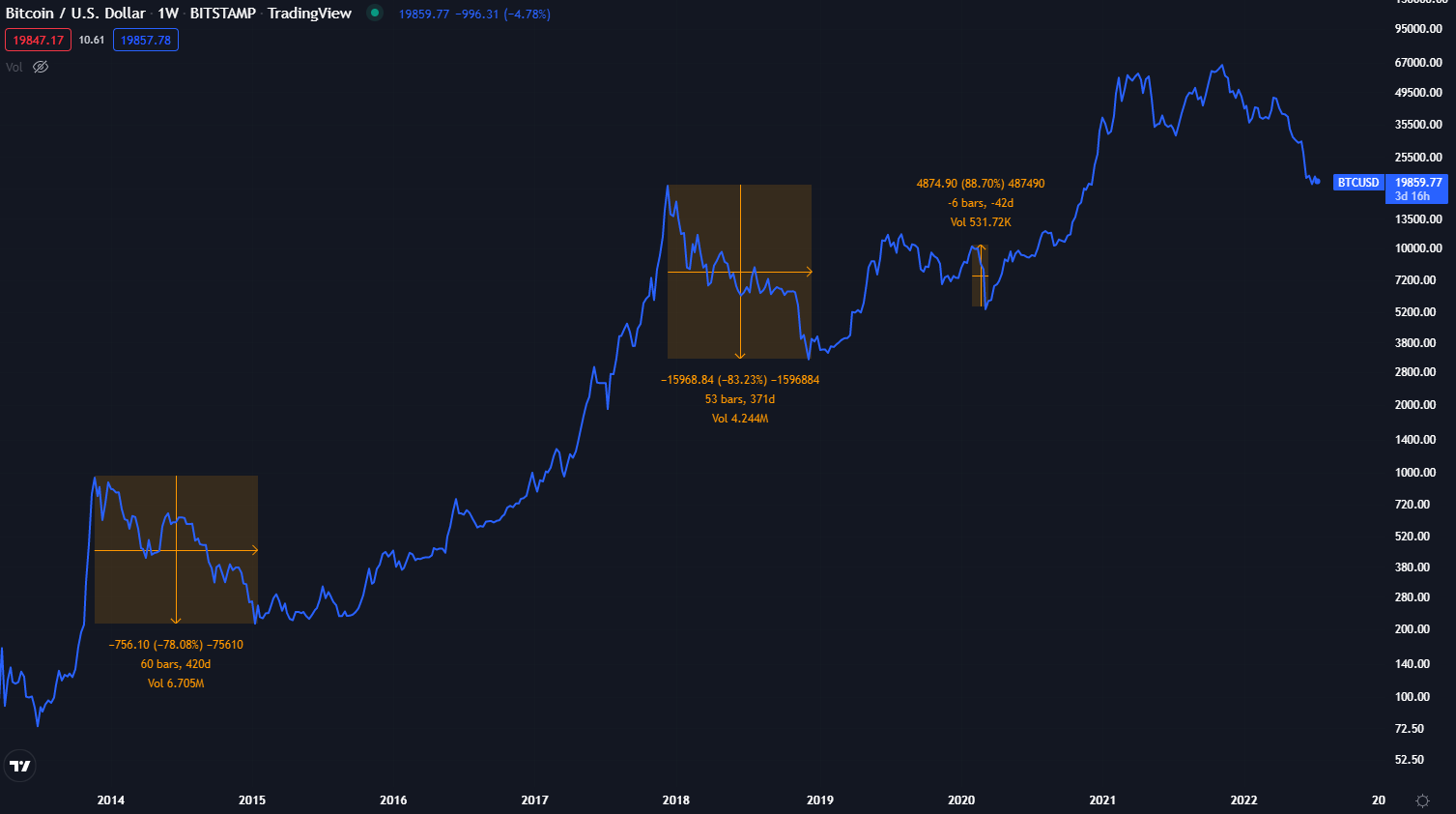
It's Possible Bitcoin Survive A Recession
Bitcoin has survived several market declines before but never a recession. So, it is likely that Bitcoin will also survive a recession without impact. Unfortunately, no one can predict the impact of a recession. Changes in the economic climate burst the speculative bubble that had been growing for much of 2021. As central banks worldwide began to raise interest rates and cease quantitative easing, all risk-on assets suffered. Until the economic climate changes, Bitcoin prices may remain relatively subdued.
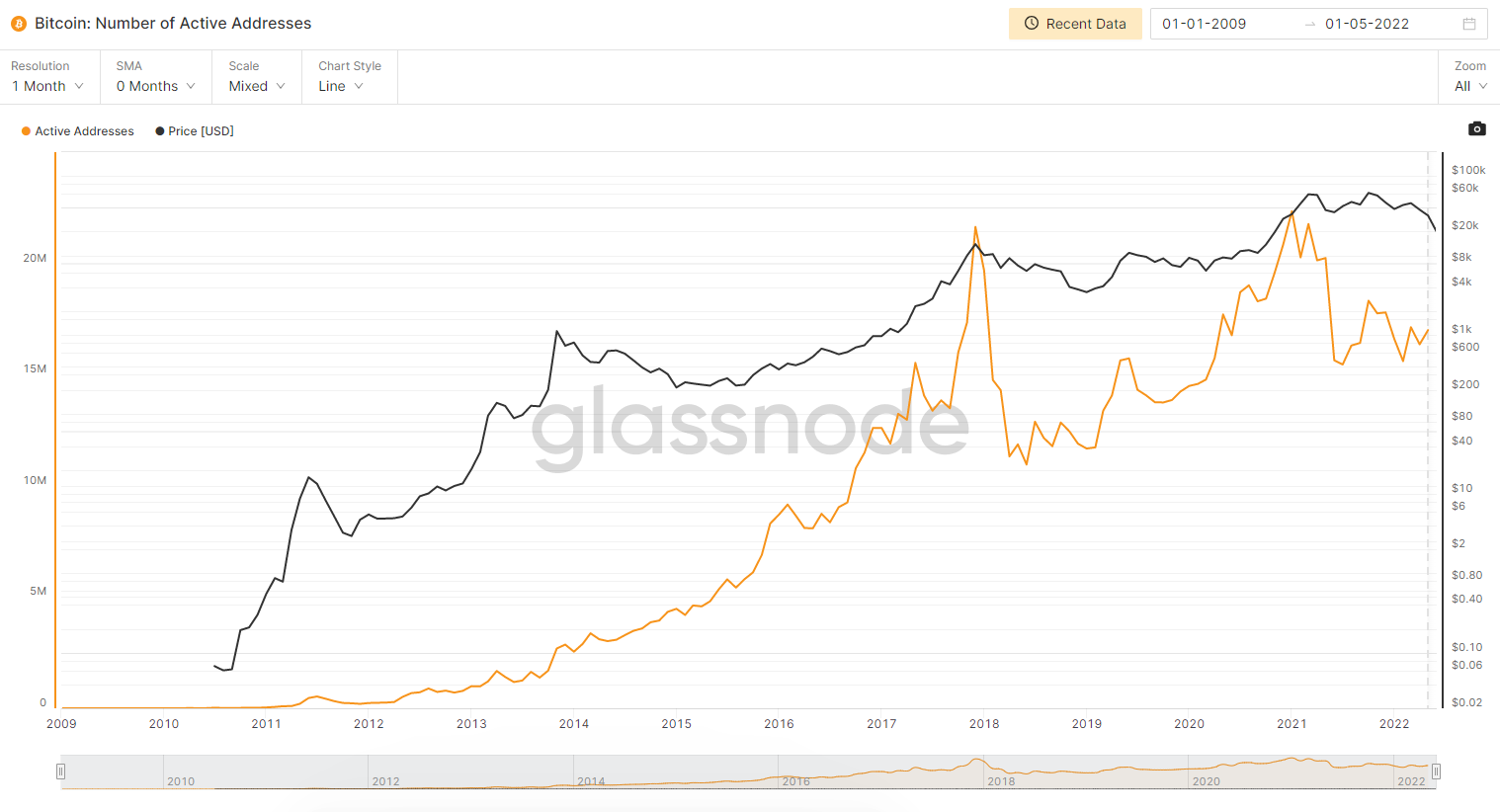
According to data collected by Glassnode, the total number of Bitcoin wallet addresses is approaching 1 billion. Although that would nearly account for an eighth of the global population, the number of Bitcoin owners stands far lower at approximately 106 million, as most cryptocurrency investors own multiple Bitcoin wallet addresses. Moreover, thanks to Active Address data from Glassnode, we can see that of 106 million owners, the number of wallets using Bitcoin on a monthly basis has not been higher than 22 million.
The figures above demonstrate that Bitcoin still has considerable room to grow in the global population. Even with the current user base, Bitcoin will likely return to all-time highs. But lower prices could bring a new wave of crypto adoption in each country.

